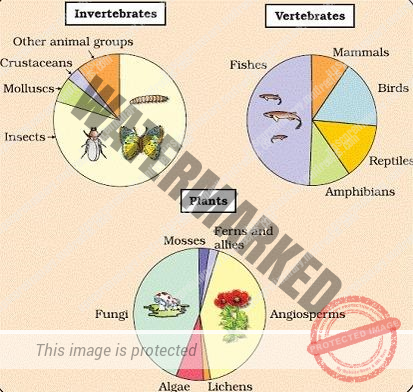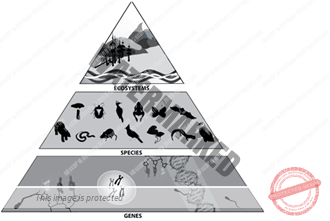- THE CLASSIFICATION OF LIVING THINGS INTO FIVE KINGDOMS
- LEVELS OF ORGANIZATION
- MEASURES OF BIODIVERSITY
UNIT 2 – BIODIVERSITY– PART 2
THE CLASSIFICATION OF LIVING THINGS INTO FIVE KINGDOMS
The first person to divide living things into five broad kingdoms was North American ecologist Robert Whittaker. Whittaker’s theory was widely accepted, and the scientific community thereby added a new group to the previous four-kingdom system, established by the American biologist Herbert Copeland in 1956.
In the most widely used system of classification these have been divided into 5 main kingdoms: Monera, Protista, Fungi, Plantae and Animalia based on certain common features and are further subdivided into many categories.
ANIMAL KINGDOM
The kingdom Animalia is the most evolved and is divided into two large groups – vertebrates and invertebrates. These animals are multi-celled, heterotrophic eukaryotes with aerobic respiration, sexual reproduction, and the ability to move. This kingdom is one of the most diverse and comprises mammals, fish, birds, reptiles, amphibians, insects, molluscs and annelids, among others.
PLANT KINGDOM
Trees, plants, and other species of vegetation make up part of the Plantae kingdom – one of the oldest, and characterised by its immobile, multicellular, and eukaryotic nature. These autotrophic things, whose cells contain cellulose, and chlorophyll are essential for life on Earth since they release oxygen through photosynthesis. As regards their method of reproduction, this may be either sexual or asexual.
FUNGI KINGDOM
This name is used to designate the fungi kingdom which includes yeasts, moulds and all species of mushrooms and toadstools. These multicellular aerobic heterotrophic eukaryotes have chitin in their cell walls, feed off other living things, and reproduce through spores.
PROTISTA KINGDOM
This group is the most primitive of the eukaryotics and all the others are descendants of it. The Protista kingdom is paraphyletic – As it is so heterogeneous it is difficult to categories it since its members have very little in common.
MONERA KINGDOM
This is the kingdom of microscopic living things and groups together the prokaryotes (archaea and bacteria). This group is present in all habitats and is made up of single-cell things with no defined nucleus. Most bacteria are aerobic and heterotrophic, while the archaea are usually anaerobic, and their metabolism is chemosynthetic.
LEVELS OF ORGANIZATION
The various species in the planet is organized into systems as the following:
SPECIES DIVERSITY
It is represented as the number of species a community consists of. For example, the Western Ghats have a greater amphibian species diversity than the Eastern Ghats. The effective number of species refers to the number of equally abundant species needed to obtain the same mean proportional species abundance as that observed in the dataset of interest. It depends mainly on climatic conditions.
ECOSYSTEM DIVERSITY
It describes the aggregation of and interaction of species with one another and deals with the variations in ecosystems within a geographical location and its overall impact on human existence and the environment especially during stress conditions. At the ecosystem level, India, for instance, with its Deserts, Rain Forests, Mangroves, Coral Reefs, Wetlands, Estuaries, And Alpine Meadows has a greater ecosystem diversity than a Scandinavian country like Norway.
GENETIC DIVERSITY
Is the total number of genetic characteristics in the genetic makeup of a species. The magnitude of variation increases along with size and environmental parameters. The genetic variation shown by the medicinal plant Rauwolfia vomitoria growing in different Himalayan ranges might be in terms of the potency and concentration of the active chemical (reserpine) that the plant produces. India has more than 50,000 genetically different strains of rice, and 1,000 varieties of mango.
WHY DO TROPICAL AREAS HAVE MORE SPECIES DIVERSITY?
Tropical environments, unlike temperate ones, are less seasonal, relatively more constant and predictable. Such constant environments promote specialisation and lead to a greater species diversity.
There is more solar energy available in the tropics, which contributes to higher productivity; this in turn might contribute indirectly to greater diversity.
AQUATIC BIODIVERSITY – It is assumed that origin of life took place in sea. This makes Marine system the richest bio diverse habitats which is playing the most important role in the maintenance of other terrestrial biodiversity. The marine plants (including micro-algal species) are responsible of fixing most of the carbon dioxide from the atmosphere and production of 65% of the oxygen. The different zones of sea such as benthic, pelagic, neritic and intertidal zone house different species of animals and plants..
MEASURE OF BIODIVERSITY
Simpson’s Diversity Index is a measure of diversity. In ecology, it is often used to quantify the biodiversity of a habitat. It takes into account the number of species present, as well as the abundance of each species. Following is the concept behind the Simpson’s diversity index.


